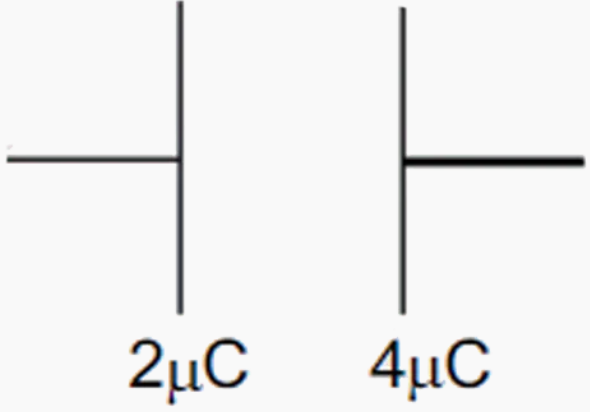The plates of a parallel-plate capacior are given equal positive charges .What will be the potential difference between the plates ? What will be the charges on the facing surfaces and on the outer surfaces ?Solution in Tamil
Step by step video & image solution for The plates of a parallel-plate capacior are given equal positive charges .What will be the potential difference between the plates ? What will be the charges on the facing surfaces and on the outer surfaces ? by Physics experts to help you in doubts & scoring excellent marks in Class 12 exams.
Topper's Solved these Questions
- BOOK - HC VERMACHAPTER - CAPACITORSEXERCISE - Objective 112videos
CAPACITORS
- BOOK - HC VERMACHAPTER - CAPACITORSEXERCISE - OBJECTIVE 27videos
CAPACITORS
- BOOK - HC VERMACHAPTER - CAPACITORSEXERCISE - worked out examples23videos
CAPACITORS
- BOOK - HC VERMACHAPTER - BOHR'S MODEL AND PHYSICS OF THE ATOMEXERCISE - Exercises46videos
BOHR'S MODEL AND PHYSICS OF THE ATOM
- BOOK - HC VERMACHAPTER - DISPERSION AND SPECTRAEXERCISE - Exercises11videos
DISPERSION AND SPECTRA
Similar Questions
A capacitor of capacitance C is charged to a potential V. The flux of the electric field through a closed surface enclosing the capacitor is
02:55View SolutionThe capacitance of a capacitor does not depend on
02:25View SolutionA parallel plate capacitor has plates of area 200cm^2 and separation between the plates 1.00 mm. What potential difference will be developed if a charge of 1.00 nC )(i.e., 1.00X10^(-9) C) is given to the capacitor? If the plate separation is now increased to 2.00 mm, what will be the new potential difference?
17:59View SolutionThe bohr radius is given by a0=ε0h2πme2 verify that the RHS has dimesions of length
02:25View SolutionA flint glass prism and a crown glass prism are to be combined in such a way that the deviation of the mean ray is zero. The refractive index of flint and crown glasses for the mean ray are 1.620 and 1.518 respectively. If the refracting angle of the flint prism is 6.0∘, what would be the refracting angle of the crown prism ?
06:09View SolutionIn a parallel plate capacitor of capacitor 1μF two plates are given charges 2μC and 4μC the potential difference between the plates of the capacitor is
 05:08View Solution
05:08View SolutionThe plates of a parallel plate capacitor are not exactly parallel. The surface charge density is therefore,
03:10View Solution(a) Find the potential difference between the plates of a parallel plate capacitor of capacitance 5muF if a charge +800muC is placed on one plate and- 200muC on another plate. (b) The charege given to plate are as shown. The capacitance between the adjacent plates is C . find the charge on outer surface of plate 3 , and potential difference between plate 1 and 2 . (c) If A is area of each plate and d is separation between adjacent plates, find the charge supplied by battery. (d) Five idential capacitor plates each of area A are arranged such that adjacent plates are at a distance d apart. the plates are connected to a source of emf V as shown. what is the magnitude and nature of charge on plates 1 and 3 respectively?
04:31View SolutionThe plates of a parallel plate capacitor are, not exactly parallel. The surface charge density therefore :
01:52View SolutionThe charges appearing on inner surfaces of a parallel plate capacitor are q_( i and )q_(2) . The charges appearing on outer surfaces of the capacitor are equal.Find the potential difference between plates of the capacitor if capacitances is C.
View SolutionA parallel plate capacitors of plate area A has a total surface charge density +sigma on one plate and a total surface charge density -sigma on the other plate. The force one plate due to the other plate is given by :
03:56View Solutionआवेशित समान्तर प्लेट संधारित्र की प्लेटों के मध्य परिणामी विद्युत क्षेत्र कितना होता है जबकि प्लेटों पर पृष्ठ आवेश घनत्व σ है ?
02:47View SolutionOne plate of a parallel plate capacitor is given a charge of 2μC. What charge will appear on four surfaces of the capacitor?
05:40View SolutionElectric potential difference between the positive plate and halfway point between the two parallel plates of a fully charged capacitor is
04:52View SolutionTwo large thin metal plates are parallel and close to each other on their inner faces the plates have surface charges densites of opposite region of the first plate (b) in the outer region of the second plate and (c ) between the plates
03:10View SolutionTwo large thin metal plates are parallel and close to each other on their inner faces the plates have surface charges densites of opposite region of the first plate (b) in the outer region of the second plate and (c ) between the plates
03:04View Solution

